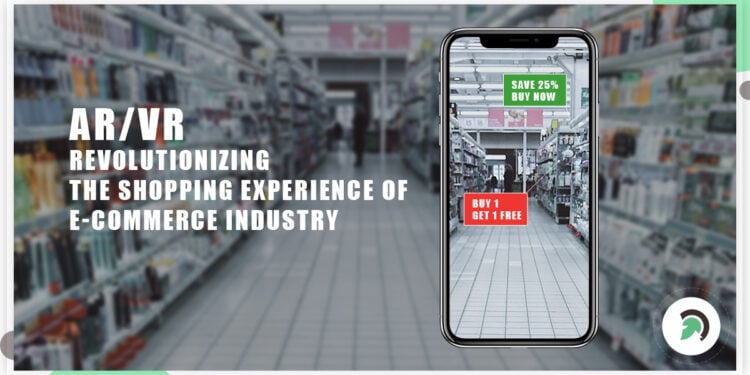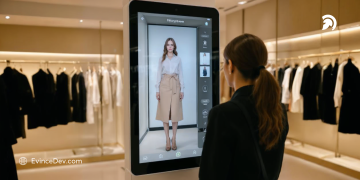Augmented Reality and Virtual Reality are the revolutionizing factors in the e-commerce industry. The expansion of virtual technology transformed a new regime for the e-commerce shopping. With endless competition, the e-commerce industry is constantly changing and the marketers who want to lead the field need to have their finger on the pulse. Evolving IT Corporates are laying importance on AR/VR since its very existence.
According to reports by nChannel, 77.24% of the shoppers abandon their cart before making a purchase. This shows that traders need to do much more to convince customers to choose and buy products online. Augmented Reality and Virtual Reality have the x-factor when it comes to online shopping- it is transforming the world of retail by providing new dimensions to the shoppers. Today, Sony and Samsung are the two biggest companies in the world of virtual reality which make advanced mobile VR products. According to a report by CCS Insight, it is estimated that more than 24 million VR products will be sold by 2018 globally leading business of $1.2 billion.
On Amazon alone, you can see there are 300 different VR headsets available, including Samsung gear VR and HTC gear VR. There are more than 500 companies on AngelList describing themselves as Virtual Technology startups. This data shows the demand for Virtual reality between users, so where does it leave eCommerce? AR and VR are revolutionizing the shopping experience in the following ways:
1. Shoppers can explore virtual showrooms at home
Virtual Reality has a ‘wow’ factor when it comes to user experience. Suppose you are running an eCommerce store where your buyers can discover, pick, checkout and pay for the products in the store. Now suppose what will happen if all these facilities can be availed at home for shoppers, your buyers wear a VR headset and find himself in your virtual shop. He can walk around, explore new items in the store and pick products exactly as he does in the real world. VR gives a three-dimensional view of shops for example- suppose a lady wants to buy a phone; she just needs to focus on the desired set she is looking for and she will get all specs along with price and best offers right in front of her in no-time. She can add products in cart and return for more window-shopping.
Retailers can build virtual showrooms to add a new level of intrigue to the online shopping. This will offer customer same level of experience as they get into a physical store in the comfort of their home. One of the major players in the Virtual Technology is Lowe’s Holoroom, they are home design industry that provides mocked-up versions of the homes and virtual rooms where users can place several products and know how their homes will look alike. The whole picture is virtually generated to give user immersive experience of their home. It’s not the only industry that benefits customers with virtual showrooms. There are many big players as well, such as eBay Australia and Myer department stores that have introduced customers to their virtual shops.
The core idea behind this technology is to give user immersive experience while conveying online shopping. The user just needs to wear a VR headset and find themselves in the mildest of the virtual shops providing realistic shopping experience at home. This technology leads all generations to shop even who are not able to visit physical stores for shopping.
2. Shoppers can virtually visualize products
This happens when we combine VR with Augmented Reality or AR. Let’s understand the AR with an example, suppose you want to buy a table for your living room. If you are in a physical store, you just assume how the table will look in your room, but with Augmented reality, you can try a variety of tables and their interface in your room through one click. If your app is AR enabled, you just need to open your mobile camera and point to the place where you want to keep your table. The moment you do this, your AR-enabled app will place a 3D model of the table in the room so that you can visualize and pick the correct table fitting for your living room.
In accordance with AR, a Swedish multinational company IKEA, have already launched an AR catalog app which allows users to see how certain furniture look at their home before purchasing it. They can visualize products in the 3D model and pick the right products according to the product and area dimensions. ECommerce store giants such as Converse and Lego also started using the AR technology to provide a new level of interaction for the customers with a slogan ‘try before you buy’.
3. It provides your customer with a new reason to visit your store
According to the Walker Sands report of 2017, a survey confirmed that many customers still prefer physical store for shopping instead of buying their products online at Amazon or eBay. With the combination of AR and VR shoppers can introduce a new world of their physical stores to their customers right in front of their home. E-commerce industry shows no signs of slowing down and more than 50% of online transactions being done from mobile shopping apps. Enabling mobile apps with AR and VR technology gives a new reason to the users to buy products online.
At Last,
Augmented reality and Virtual reality showed impressive growth letting e-commerce and internet retail giants enter the virtual world. Recently, Amazon launched an AR integrated shopping app for the iOS users. In accordance with Amazon, eBay also shacked hands with an Australian retailer Myers to launch a virtual department store. New companies are very enthusiastic in combining AR-VR with e-commerce and some of them are even becoming important acquisition targets as well.
This is the third most popular platform after app and desktops for online shopping. As AR / VR technology turns out to be more open and standardized, e-commerce industry will benefit and gain a competitive advantage from it.




